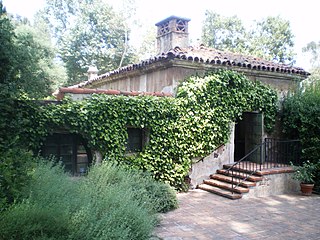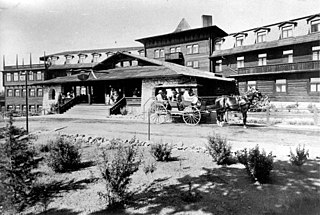
Mission San Gabriel Arcángel is a Californian mission and historic landmark in San Gabriel, California. It was founded by the Spanish Empire on "The Feast of the Birth of Mary," September 8, 1771, as the fourth of what would become twenty-one Spanish missions in California. San Gabriel Arcángel was named after the Archangel Gabriel and often referred to as the "Godmother of the Pueblo of Los Angeles."

Henry Edwards Huntington was an American railroad magnate and collector of art and rare books. Huntington settled in Los Angeles, where he owned the Pacific Electric Railway as well as substantial real estate interests. In addition to being a businessman and art collector, Huntington was a major booster for Los Angeles in the late 19th and early 20th centuries. Many places in California are named after him.

Don Manuel Domínguez e Ybáñez (1803–1882) was a Californio ranchero, politician, and a signer of the California Constitution in 1849. He served as two terms as Alcalde of Los Angeles (mayor). He was one of the largest landowners in Southern California, having inherited Rancho San Pedro in 1825, one of the largest ranchos in California. He was one of the founders of the cities of Carson and Compton and of the fishing village of San Pedro. Today, California State University, Dominguez Hills and the communities of Rancho Dominguez, East Rancho Dominguez, and West Rancho Dominguez bear his family's name.

John Steven McGroarty was a poet, Los Angeles Times columnist, and author who also served two terms as a Democratic Congressman from California from 1935 to 1939.

St. Andrew's Catholic Church is a Catholic church in Pasadena, California. Founded in 1886, it is the oldest Catholic parish in Pasadena and one of the oldest in Los Angeles County. Its Romanesque Revival campanile bell tower is visible for miles and is one of the landmarks of Pasadena. The interior of the current church, built in 1927, was modeled after the Basilica of Santa Sabina in Rome, while the façade was modeled after the church of Santa Maria in Cosmedin, down the hill and slightly upriver from Santa Sabina.

George Allan Hancock was the owner of the Rancho La Brea Oil Company. He inherited Rancho La Brea, including the La Brea Tar Pits which he donated to Los Angeles County. He also developed Hancock Park, Los Angeles. He was vice president of the Los Angeles Hibernian Bank, treasurer of the Los Angeles Symphony Association, and president of the Automobile Association of Southern California. He owned the Santa Maria Valley Railroad, established Rosemary Farm, and developed the Santa Maria Ice and Cold Storage Plant.

El Molino Viejo, also known as The Old Mill, is a former grist mill in the San Rafael Hills of present-day San Marino, California, United States, and was built in 1816 by Father José María de Zalvidea from the Mission San Gabriel Arcángel. It is the oldest commercial building in Southern California, and was one of the first ten sites in Los Angeles County to be listed on the National Register of Historic Places, receiving the recognition in 1971. The Old Mill has also been designated as a California Historical Landmark.
Rancho San Jose was a 15,000-acre (61 km2) Mexican land grant in northeastern Los Angeles County given in 1837 by Governor Juan Bautista Alvarado to Ygnacio Palomares and Ricardo Véjar. Today, the communities of Pomona, LaVerne, San Dimas, Diamond Bar, Azusa, Covina, Walnut, Glendora, and Claremont are located in whole or part on land that was once part of the Rancho San Jose.

Arthur Letts Sr. was an immigrant from England who made his fortune in Los Angeles, California, in the early years of the 20th century. He built his wealth by transforming a small, bankrupt dry goods store in Downtown Los Angeles into the prominent The Broadway department store, later adding the Bullock's store.

Fred Hartsook was an American photographer and owner of a California studio chain described as "the largest photographic business in the world" at the time, who counted Henry Ford, Charles Lindbergh, Mary Pickford, and sitting President Woodrow Wilson among his celebrity clients. He later became the owner of the Hartsook Inn, a resort in Humboldt County, and two ranches in Southern California on which he reared prized Holstein cattle. Hartsook was married to Bess Hesby, queen of the San Francisco Pan-Pacific Exposition of 1915.
Pasadena is a city in Los Angeles County, California, United States. Founded in 1874 and incorporated in 1886, the city is famous for its colorful history and for the hosting of both the Tournament of Roses Parade and the annual Rose Bowl game football game. It is also the home of the world-renowned California Institute of Technology (Caltech) and Jet Propulsion Laboratory (JPL)

Charles Frederick Whittlesey (1867–1941) was an American architect best known for his work in the American southwest, and for pioneering work in reinforced concrete in California.

The Mission Revival style was part of an architectural movement, beginning in the late 19th century, for the revival and reinterpretation of American colonial styles. Mission Revival drew inspiration from the late 18th and early 19th century Spanish missions in California. It is sometimes termed California Mission Revival, particularly when used elsewhere, such as in New Mexico and Texas which have their own unique regional architectural styles. In Australia, the style is known as Spanish Mission.
George Albert Ralphs was an American businessman. He founded the Ralphs supermarket chain in Southern California, with the help of his brother Walter.

Jacob Kuhrts original spelling Kuhrt), nicknamed "Uncle Jake", left home at age 12 as a cabin-boy on an English clipper and spent 6 years sailing around the world before he eventually disembarked in Monterey, California in 1848. He then spent several years working at the Mission Dolores in San Francisco prior to the discovery of Gold in Placer county when he worked as a miner during the California Gold Rush. Later after travelling south to the small pueblo of Los Angeles around 1859 when the town had a population of less than 5,000, he became active as a teamster, a merchant, Los Angeles County Coroner (1870–1873),the first volunteer Fire Commissioner Chief in Los Angeles (1886–1900), and as a member of the Los Angeles City Council from 1876 to 1877 and again in 1880 when he served as council president. He had the first 2-story brick building constructed in downtown Los Angeles which also served as the family compound, retail store, and upstairs rental units.

The San Gabriel Mission Playhouse is a historic performing arts venue located in the Mission District of the city of San Gabriel, California, United States.
Joseph W. Wolfskill and Louis Wolfskill were brothers who were members of the Los Angeles, California, Common Council, the legislative arm of that city's government, between 1874 and 1884. They were landowner successors to their pioneer Southern California father, William Wolfskill.

George Smith Patton was an American attorney, businessman and politician who served as Los Angeles County District Attorney and the first mayor of San Marino, California.

Hugh Livingstone Macneil was a pioneer rancher and town developer in southern California.

Eli P. Clark (1847–1931) was a pioneer railway builder of Southern California and a leader in the civic, philanthropic and social activities of Los Angeles.
















